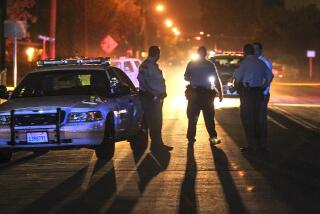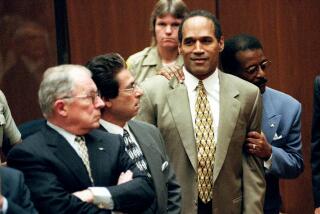Victims’ families hope for answers in LAPD’s homicide library
Adrian McFarland awoke in a panic. His brother had come to him again in a dream. In this one, McFarland walked into a bar and there his brother stood, flashing a toothy smile.
But Charles had been gone for nearly two decades, shot to death in Los Angeles when he was 27.
McFarland, younger by four years, knew little about the crime. The dreams, he thought, were a sign. After all these years, had anyone been caught?
A few days later, LAPD Det. Mark Hahn’s phone rang. McFarland was on the line from Monroe, La., with questions long unasked.
These calls never got easier for Hahn, even after 14 years working homicide: families checking in on the anniversary of a killing or the victim’s birthday, their grief renewed by a date on the calendar.
Usually, answers would have been hard to come by, especially for a case so old.
But this time, Hahn knew where to turn: to the detectives creating the Los Angeles Police Department’s first library of homicide.
::
In an office normally reserved for LAPD chaplains at the Ahmanson Recruit Training Center in Westchester, boxes are stacked more than 4 feet high, each labeled with a letter and a number. Two other rooms hold more files; cops call them “murder books.”
A large lecture room serves as the homicide library’s headquarters. It’s lined with blue and black binders labeled with names and dates, and in the middle of the room files are neatly organized in rows. This is where Det. Teddy Hammond maintains a spreadsheet tracking the location of each file.
“Everything I deal with in that room is about death,” said Hammond, a homicide investigator with more than a decade of cases under his belt. “The families, the aftermath. People calling. Victims’ families not satisfied by the results….”
For two years, Hammond and several other detectives have organized the binders, getting them ready to be scanned. They’ve seen crime scene photos, Polaroids of witnesses, medical reports, notes scrawled on yellowing paper.
The task wasn’t feasible before because of a lack of resources, but this first-of-its-kind partnership with the FBI will place sought-after information a click away for detectives, who sometimes spend weeks tracking down a file’s location. When the database is complete, investigators will be able to search any aspect of a murder book, including license plate numbers and gang monikers.
First, the department plans to digitize more than 4,500 files from the southern part of the city — long the deadliest — between 1990 and 2010. Eventually, cases from the entire city will be included. Officials plan to open the doors to a brick-and-mortar library where families can go for answers and detectives can check out files.
“No case will be lost,” said Tom McMullen, a recently retired LAPD captain, who oversaw the group of detectives who handle the area covered in the database.
McMullen called the database a “one-stop shop” that will make it easier to piece together cases involving multiple murders, such as the Grim Sleeper serial killer.
The files — solved and unsolved — portray some of the bloodiest years in the city, an era of violence before cellphones and the widespread use of DNA. It was a time when detectives were called from one crime scene to the next, often without pause. Investigators were working 18-hour days and losing sleep, only to return to files piled high on their desks.
There’s the case of Jane Doe #62, who was discovered in a South Los Angeles park in 1991, naked from the waist down, her face in a pool of blood. Detectives worked leads that stretched to Mexico, but she was never identified, and the case was never solved.
In 1992 came the killing of Samuel Lewis Grayson. After running into rival gang members at a gas station, he was followed, then shot with a semiautomatic weapon while driving on Jefferson Boulevard. But suspects were never identified in the case. That year was one of the most violent, with 1,092 killings, more than three times the number of homicides the city sees today.
One year later, Joong Kun Lee was shot to death while opening up his liquor store in South-Central. Lee, married for nearly two decades, was found in the back of the store Oct. 23, wedged in the back entrance between the door and the wall. The unsolved case came within weeks of three other killings of Korean American business operators.
Hammond, who prides himself on his detective skills, read through cases only to come away angry and frustrated by what he saw as shoddy policework. Some families never even received a phone call.
As he delved deeper into the files, he realized that investigators had been strained by the violence. There simply weren’t enough of them.
“They were swamped,” Hammond said.
One day, Hammond was sorting through files when he saw a name he recognized.
He paused.
Wait a minute, he thought. I know this name.
It was the file of his cousin Sobu Sisiall Hammond, killed May 30, 1994. He was 19.
Hammond read through the file.
I have someone in here too, he thought.
Now, he says, the library is about moving forward and making amends.
It’s about being able to find the file of Charles McFarland, shot to death in 1995. He was one of 838 killings in L.A. that year. Before, detectives would have had to search through several storage facilities, and even then it might have been misfiled. Hammond found the file within hours.
::
On the phone, Hahn gave Adrian McFarland the details of the long-dormant case.
His brother had been killed as he was hawking ice cream from a cooler outside a convenience store off South Vermont Avenue and West 77th Street.
A man ran into the store and held the owner up at gunpoint as another man kept watch.
As the store owner was on the ground, he heard gunshots. Moments later, the owner found McFarland collapsed in the doorway of a nearby store.
Adrian McFarland listened to Hahn. The facts weren’t enough.
The detectives in L.A. needed to know that someone really cared about this man. He wanted to know more, to feel closer to his brother.
A month later, McFarland sat inside a small interview room 1,700 miles away from home with tears running down his face. He’d ridden his motorcycle across the country with a friend to see for himself.
Hahn asked, “As far as you knew, everything was going fine out here?”
“Yes.”
Charles had come out to L.A. to be with a woman, McFarland remembered. It had been hard for him to get a job, but he found a “little gig” and seemed content.
McFarland and his friend drove to the crime scene with Hahn and his partner, Jorge Gutierrez.
At the former convenience store, now a TV sales and repair shop, McFarland snapped pictures.
He asked where, exactly, did his brother collapse?
Hahn and Gutierrez pointed. McFarland wondered what his brother’s last words were.
“You shouldn’t be able to kill people and get away with it,” McFarland said.
Hahn said he would run DNA found at the scene for a possible match.
“We’re going to make the extra effort,” Hahn said. The group quietly walked back to the unmarked police car.
Back home in Louisiana, McFarland holds out hope.
He keeps Hahn’s phone number handy. He says he’ll keep it for as long as it takes.
More to Read
Start your day right
Sign up for Essential California for news, features and recommendations from the L.A. Times and beyond in your inbox six days a week.
You may occasionally receive promotional content from the Los Angeles Times.







